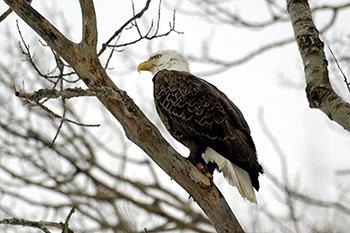Bald eagles: From brink of extinction to robust recovery

While enjoying the great outdoors this summer, keep your eyes to the skies for bald eagles – our national emblem. These very large raptors can be found fishing and scavenging along Michigan’s lakes and rivers.
Despite their name, bald eagles are not actually bald. Adults have white heads and tails that contrast with their dark brown bodies. Juveniles, which will be leaving their nests this month, have dark brown bodies, heads and tails, with brown and white mottling.
Bald eagles have become a popular sight across Michigan and are expanding in southern Michigan as they adapt to nesting in more open and urban landscapes. Recent statewide surveys found approximately 900 breeding pairs in the state. This compares to only 359 breeding pairs in 2000 and 83 in 1980. And 60 years ago, you would not have been able to see bald eagles across much of Michigan or the United States. In 1963, the U.S. bald eagle population had reached an all-time low of 417 nesting pairs across the lower 48 states, and the bird was an endangered species.
| Their populations declined due to loss of nesting habitat, persecution by humans and a pesticide called DDT, which caused reproductive problems that accelerated population declines in the 1950s and 1960s. Michigan led the way in bald eagle conservation and was the first state to ban DDT in 1969, three years before it was banned nationally. The Endangered Species Act of 1973 additionally increased protections and funding to support the recovery of endangered species like the bald eagle.
Erin Roward Ford, conservation manager for Michigan with Audubon Great Lakes, works in partnership with the DNR on MI Birds. She said that after near-extinction in the mid-20th century, there now are more than 300,000 bald eagles in the wild across the country. “The species’ recovery is a success story, one that speaks to the groundbreaking work of conservationists and researchers, which led to policies that continue to protect wildlife today,” she said. Bald eagles are no longer on the endangered or threatened species list, but are still federally protected under the Migratory Bird Treaty Act and the Bald and Golden Eagle Protection Act. “You can help bald eagles succeed in Michigan by keeping a safe distance from nests and avoiding certain activities that could disturb them,” said Chris Mensing, a U.S. Fish and Wildlife Service biologist based out of Lansing, Michigan. “When outdoors, take a moment to clean up trash, safely dispose of old fishing line and lures, and avoid using lead shot and lead tackle.” Questions? Contact Nicole Minadeo, Audubon Great Lakes communications director, at 419-308-4846. |





